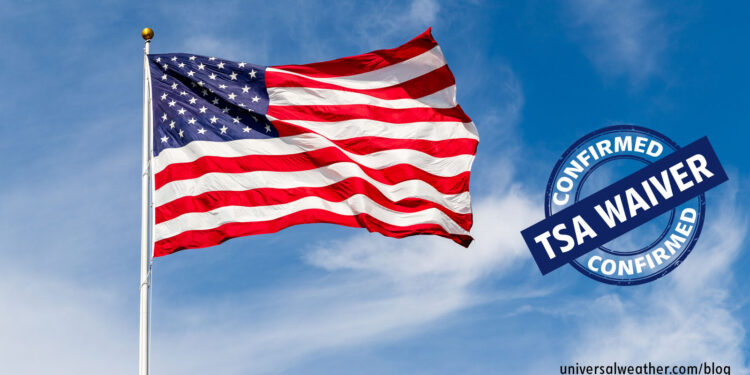Business Aviation Trip Planning Tips: TSA Waivers – Part 2: Application Process

This business aviation blog post continues from our article last week, entitled “Business Aviation Trip Planning Tips – TSA Waivers – Part 1: Knowing When to Apply for One.”
The Transportation Security Administration (TSA) waiver application process is now more streamlined and user-friendlier than it was in the past. For instance, the entire filing process is online, and the information you provide is saved for ease of future waiver filings.
The following is an overview of what you need to know about the TSA waiver application process:
1. Understand the TSA waiver application process
TSA waiver applications are normally submitted online and include five sections:
- “Proponent section” covers details on the waiver requestor, operator, and aircraft owner (who may all be the same entity).
- “Itinerary section” indicates subtype and flight type details; however, no differentiation is made between private non-revenue and charter operations. Itinerary includes start and end dates, along with departure, intermediate stop, destination, and final destination details. Departure, intermediate, destination, and final destination stops do not need to be in any particular sequence, as long as all stops are listed.
- “Aircraft information” covers registration, call sign, maximum takeoff weight (MTOW), and aircraft type.
- “Manifest page” lists pilots, non-pilot crew members, and passengers, with full names, dates of birth, cities and countries of birth, passport numbers, and – in the case of pilots – airline transport pilot numbers and issuing authorities.
- “Security statement” involves three questions and covers how the aircraft is secured when not being used, how crew members/pilots/passengers are vetted pre-boarding, and other security protocols such as baggage screening.
2. TSA waiver applications are processed online
TSA waivers are always submitted online, and there’s no longer a requirement to fill out or sign forms manually. Since mid-2012, all applications are stored online and can be recalled by operators when needed. So, if you’re planning a new TSA waiver request, or revising an existing waiver authorization, you’ll be able to pull up all your information online and avoid having to fill out another application in its entirety.
3. Know lead time for TSA waivers
Official application lead time is five business days. Short-notice requests may be accepted, but there’s no guarantee that your application will be processed in less than official lead time. For short-notice requests always call TSA by phone to let authorities know your situation. Otherwise, any request with a start date within the five business days may automatically be rejected. Keep in mind that TSA’s application office does not operate 24 hours. Normal business hours are 0700-1700 Eastern time, and they’re closed on weekends and public holidays. Once a request has been submitted, the system gives you a confirmation receipt number (tracking number) that can be used for follow-up.
4. Revisions may be requested
There’s an online function available to modify existing TSA waivers, and processing time for this is five business days as well. Once a modification request is submitted, your current TSA waiver will no longer be valid and cannot be used in the interim. For this reason, it’s recommended that a new, additional waiver request be submitted rather than modifying the existing waiver you already have so that you can continue using it. And, your new additional waiver request will need to have the same expiration date as your original waiver.
To help highlight how this will work, see the following example below:
Suppose you have a TSA waiver that has multiple aircraft and destinations on the approval:
TSA Waiver 1 – XYZ Company
Approved aircraft registrations:
NXXX1
NXXX2
NXXX3
NXXX3
Approved waiver destinations:
KBGR, KEWR, KLAX, KLAS, KNEW, KJFK, KNEW, KFLL
Validity:
April 1-June 28
If aircraft NXXX3 has a last-minute trip to KOPF on May 5, the operator has two options:
- Submit a revision to the current waiver, which will immediately invalidate it until it receives a revised confirmation. This means that none of the other aircraft on that waiver can utilize the original waiver.
- Submit a new request for a TSA waiver just for NXXX3 and only to travel to KOPF. When applying for this waiver, the expiration date must match the expiration date of the original waivers (TSA Waiver 1). This is by regulation.
TSA Waiver 2 – XYZ Company
Approved aircraft registrations:
NXXX3
Approved destinations:
KOPF
Validity:
May 5-June 28
By obtaining a waiver for NXXX3 for the last-minute trip, it allows the operator to be able to utilize TSA waiver 1 for his or her other aircraft conducting trips to the approved destinations on the waiver.
5. Some operations require route approval along with a TSA waiver
Along with TSA waivers there are routing approvals that must be obtained for aircraft registered in certain special-interest countries. If your aircraft is registered in China (PRC), Cuba, Iran, North Korea, Russia, Sudan, or Syria, you’ll need both a TSA waiver and Federal Aviation Administration (FAA) routing approval for every flight into and out of the U.S. In this case it’s recommended that the TSA waiver be submitted first in order to get the tracking number. TSA will forward the waiver request to the FAA for review. Your routing request will be submitted separately to the FAA, and this process takes two business days. Once the routing is approved by the FAA, it must be followed exactly. Both TSA waiver confirmation and FAA routing approval number need to be added to the remarks section 18 of your flight plan.
Additional Tips
When submitting a TSA waiver request, monitor the process to ensure that nothing is rejected. Waiver approvals only list flight crew members – and not non-flying crew members or passengers. Should you substitute passengers or non-flying crew members, it’s best to inform TSA of these changes, even though these names will not appear on the waiver.
Questions?
If you have any questions about this blog article or would like assistance obtaining your TSA waiver, contact me at juanmuniz@univ-wea.com.




